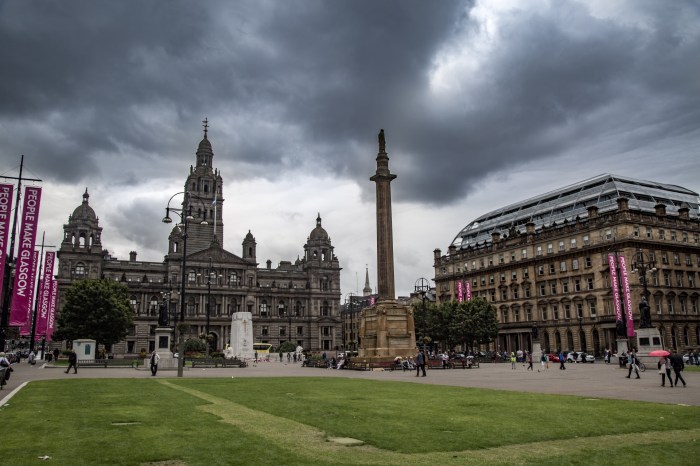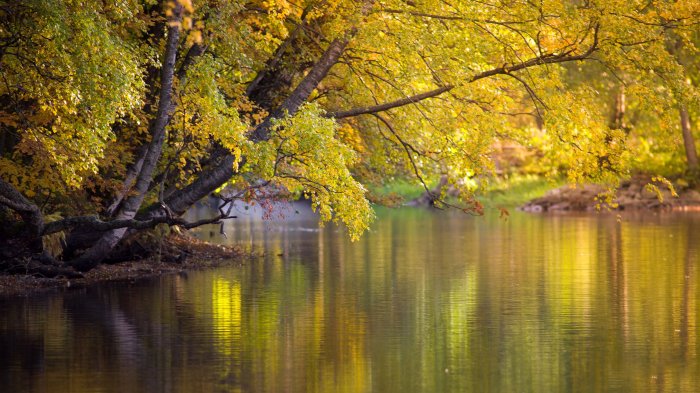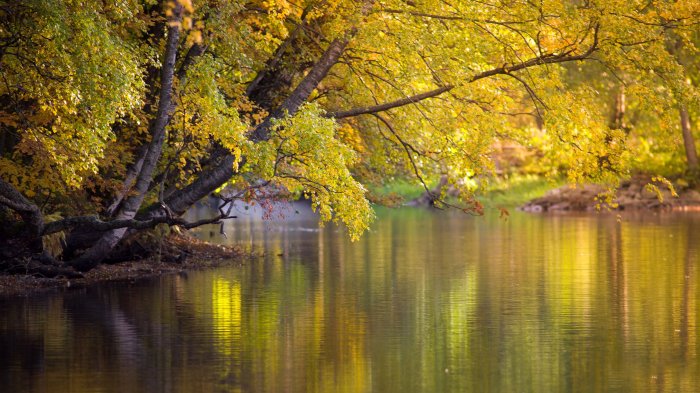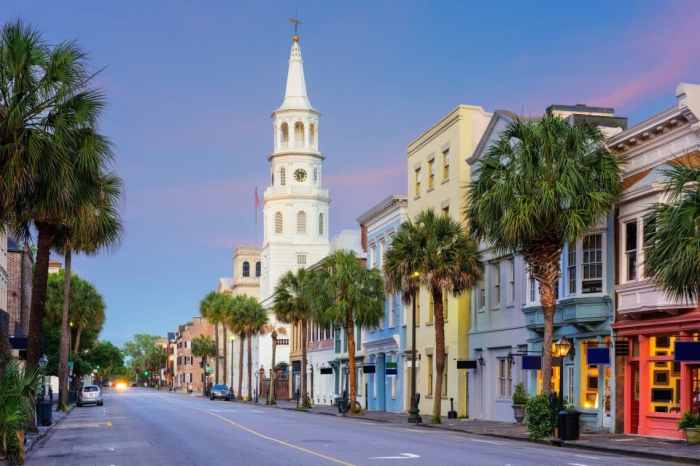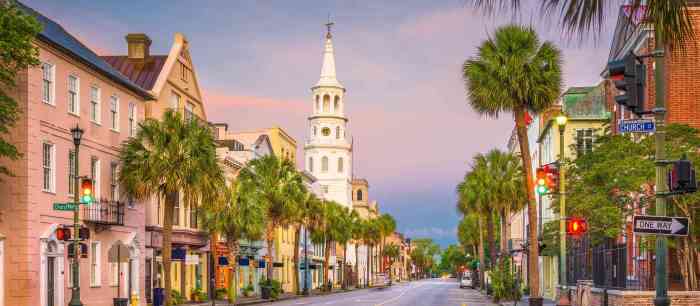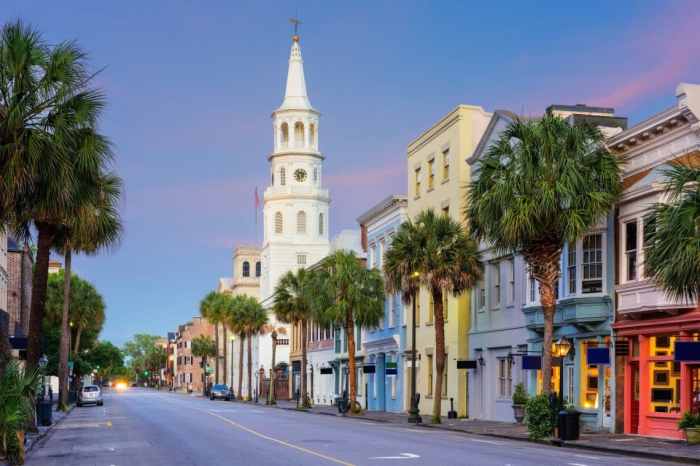Glasgows best day trips – Glasgow’s best day trips: Unveiled. From historic castles to breathtaking landscapes, discover the hidden gems just a short journey from the city. This guide explores a range of day trip options, catering to every traveler, whether you’re a history buff, a nature enthusiast, or a family seeking adventure.
This comprehensive guide dives deep into planning the perfect day trip. We’ll cover everything from historical sites to scenic routes, and include practical information like transportation, accommodation, and local experiences to help you craft unforgettable memories.
Introduction to Glasgow Day Trips
Escape the city buzz and explore the wonders surrounding Glasgow! Day trips offer a fantastic way to experience Scotland’s rich history, breathtaking landscapes, and vibrant culture, all within a manageable timeframe. Whether you’re seeking a dose of history, a scenic stroll through nature, or a cultural immersion, Glasgow’s surrounding areas provide a plethora of options to suit every interest and travel style.This article provides a comprehensive overview of the various day trips available from Glasgow, highlighting their unique appeal and targeting specific interests.
We’ll delve into the different types of excursions, from historical castles to picturesque countryside walks, and explain how these trips cater to different traveler profiles, from families to solo adventurers. This structured guide will make planning your perfect Glasgow day trip a breeze.
Types of Day Trips
Day trips from Glasgow cater to diverse interests. These excursions can be broadly categorized as historical, scenic, cultural, and leisure-focused. Historical trips offer insights into Scotland’s past, scenic journeys provide breathtaking views, cultural trips immerse you in local traditions, and leisure trips focus on relaxation and enjoyment.
Historical Day Trips
These trips focus on Scotland’s rich history, exploring ancient castles, historical sites, and significant landmarks. Examples include visits to Stirling Castle, a magnificent medieval fortress, or the impressive Edinburgh Castle, with its panoramic views and historical significance. These excursions are ideal for history buffs and those seeking a glimpse into Scotland’s past. Learning about historical figures, witnessing architectural marvels, and understanding Scotland’s royal heritage are key elements of these trips.
Scenic Day Trips
Glasgow’s surrounding areas offer stunning landscapes, perfect for scenic day trips. Loch Lomond and the Trossachs National Park, renowned for its dramatic mountains, lochs, and forests, provides opportunities for hiking, cycling, and simply soaking in the breathtaking scenery. These trips are perfect for nature lovers, photographers, and those seeking a peaceful escape from the city. The tranquility and beauty of the Scottish Highlands are captivating elements of these trips.
Cultural Day Trips
Immerse yourself in Scottish culture with a day trip to a charming town or city. Explore the vibrant arts scene in Edinburgh, with its world-class museums, theaters, and galleries, or discover the local traditions and crafts in a smaller town like Oban. These trips are ideal for those interested in art, culture, and local experiences. Learning about local traditions, experiencing local cuisine, and engaging with local communities are important elements of these trips.
Leisure Day Trips
These trips offer a chance to relax, unwind, and enjoy leisure activities. Visiting a spa or enjoying a leisurely stroll along a scenic coastal path are examples. These trips are perfect for those seeking relaxation, rejuvenation, and a break from the hustle and bustle of daily life.
Target Audience
These day trips cater to a wide range of travelers. Families can enjoy the historical sites and scenic routes. Couples can explore charming towns and indulge in leisurely activities. Solo travelers can embark on independent adventures and immerse themselves in the local culture. The variety of day trips available ensures that there is an option to suit every interest and travel style.
Historical & Cultural Day Trips
Unveiling the rich tapestry of Scottish history and culture is just a day trip away from Glasgow. From ancient castles steeped in legend to charming towns brimming with historical significance, these destinations offer a captivating glimpse into the past and a deeper understanding of Scotland’s identity. This exploration will highlight the most popular historical sites, their cultural appeal, and how to reach them from Glasgow.These day trips provide a wonderful opportunity to escape the city’s bustle and immerse yourself in the stories and atmosphere of Scotland’s historic heartland.
Glasgow’s got some amazing day trip options, from the stunning Loch Lomond & The Trossachs National Park to the historic charm of Edinburgh. But if you’re looking for a different kind of adventure, consider checking out Italy’s free museum Sunday initiative – it’s a great way to explore a different culture without breaking the bank. You can find out more about italy free museum sunday back and then maybe plan a day trip to explore a museum or two yourself! Glasgow’s best day trips are still some of the best, even with this extra option.
They are perfect for history buffs, families seeking enriching experiences, or anyone looking for a change of pace.
Popular Historical Sites
Scotland boasts a wealth of historical sites easily accessible from Glasgow. These locations offer a unique blend of architectural marvels, tales of the past, and the opportunity to experience Scottish culture firsthand.
- Stirling Castle: A majestic medieval fortress, Stirling Castle stands as a symbol of Scotland’s history. Its strategic location and role in significant battles have shaped Scottish identity. The castle offers guided tours that bring its rich past to life, allowing visitors to walk in the footsteps of kings and queens and experience the atmosphere of centuries past. The intricate architecture and fascinating displays provide a tangible connection to Scottish history.
Travel time from Glasgow is approximately 1 hour by car or train. Entry fees vary depending on the time of year and the specific tour chosen. Opening hours are typically from 9 am to 5 pm, but check the official website for the most up-to-date information.
- Edinburgh Castle: Situated atop Edinburgh’s Royal Mile, Edinburgh Castle commands breathtaking views of the city. A powerful symbol of Scottish sovereignty, the castle has witnessed centuries of Scottish history, from its early role as a royal residence to its later importance in Scottish warfare. The castle’s extensive collection of historical artifacts, including weaponry, royal regalia, and significant historical documents, gives a profound insight into the past.
The sheer scale of the castle, its strategic position, and the stories it holds make it a must-see for history enthusiasts. The journey to Edinburgh takes approximately 1 hour by train, or 1 hour 30 minutes by car. Entry fees and opening hours are available on the official website.
- Dumbarton Castle: Perched atop a dramatic crag overlooking the River Clyde, Dumbarton Castle offers panoramic views and a fascinating glimpse into the past. A vital strategic location, it played a pivotal role in Scottish history. Exploring the castle’s ruins allows visitors to imagine life in medieval times, to understand the castle’s defensive architecture, and to envision the strategies employed by those who once resided there.
The travel time from Glasgow is approximately 45 minutes by train or 30 minutes by car. Opening hours and entry fees are available on the official website.
Cultural Experiences at These Locations
These destinations aren’t just about history; they are living cultural experiences.
- Stirling Castle: The castle grounds often host cultural events and festivals, providing a dynamic environment to connect with the Scottish people and their traditions. Guided tours, workshops, and historical reenactments offer immersive experiences, allowing visitors to step into the past.
- Edinburgh Castle: Edinburgh Castle is not just a historical landmark but also a vibrant cultural hub. The castle hosts a variety of performances, concerts, and exhibitions throughout the year. The city surrounding the castle offers numerous opportunities to immerse yourself in the vibrant arts and culture scene of Scotland.
- Dumbarton Castle: The surrounding area of Dumbarton Castle offers a chance to explore the local culture and traditions. You can discover local shops, pubs, and restaurants that offer authentic Scottish experiences.
Transportation and Travel Times
Convenient transportation options make these day trips accessible from Glasgow.
| Destination | Transportation | Travel Time (approx.) |
|---|---|---|
| Stirling Castle | Train/Car | 1 hour |
| Edinburgh Castle | Train/Car | 1 hour / 1 hour 30 minutes |
| Dumbarton Castle | Train/Car | 45 minutes / 30 minutes |
Entry Fees and Opening Hours
Precise details on opening hours and entry fees are essential for planning your trip.
- Check the official website of each attraction for the most up-to-date information. These websites provide schedules, ticket prices, and special offers, ensuring you have the most accurate and relevant details for your trip.
Scenic & Outdoor Day Trips
Beyond the bustling city, Glasgow offers a wealth of breathtaking natural escapes within easy reach. From rolling hills to dramatic coastlines, these destinations provide a welcome contrast to the urban landscape, perfect for exploring nature’s beauty and enjoying outdoor activities. These day trips offer a chance to immerse yourself in Scotland’s stunning scenery and create lasting memories.Exploring Scotland’s diverse landscapes from Glasgow is a fantastic way to experience the beauty of the Scottish countryside.
Glasgow’s got some amazing day trip destinations, like Loch Lomond and the Trossachs National Park, or a scenic trip to the coast. But if you’re looking for a fantastic vegan meal while you’re exploring the city, check out some of the best vegan restaurants in Washington DC, like best vegan restaurants in Washington dc. These places offer a wide range of delicious options, making your trip even better.
Afterwards, you can head back to Glasgow for more exploring.
These excursions cater to various interests, from hiking enthusiasts to those seeking peaceful walks or wildlife spotting. The varying terrains and attractions provide options for everyone, regardless of their preferred activity.
Loch Lomond & The Trossachs National Park
This stunning national park, just a short drive from Glasgow, is a haven for outdoor lovers. The loch itself is a majestic expanse of water, framed by towering mountains and picturesque villages. The park’s diverse terrain caters to different levels of activity, with everything from leisurely strolls along the lochside to challenging hikes through the hills. Wildlife spotting is also a popular pastime, with opportunities to see red deer, birds of prey, and various other species.
The park is particularly beautiful in the summer months, with warm weather and long daylight hours ideal for hiking and enjoying the outdoors.
The Scottish Highlands
The Scottish Highlands, while encompassing a vast area, offer numerous day trip destinations accessible from Glasgow. These areas are characterized by dramatic mountain ranges, rugged landscapes, and picturesque lochs. The region’s varied topography offers opportunities for exploring various natural environments, from the heights of Ben Lomond to the tranquil waters of Loch Ness (a popular day trip destination, though may require overnight stay).
Activities range from hiking and walking to scenic drives and wildlife viewing. A visit to the Highlands often involves experiencing the region’s rich history and culture through local villages and historic sites.
The Clyde Coast
The Clyde Coastline offers a different perspective of Scotland’s natural beauty. This coastal region presents a diverse mix of landscapes, from sandy beaches to dramatic cliffs and rocky shores. Coastal walks and exploring the region’s charming fishing villages are popular activities. The Clyde’s coastline offers a range of experiences, with the ability to discover secluded coves and stunning views.
The area is especially popular for birdwatching and enjoying the fresh sea air. Autumn offers vibrant colours and pleasant weather for exploring the coast.
Best Time to Visit
The best time to visit these destinations depends heavily on the specific activity you plan to enjoy. Summer is generally ideal for hiking and enjoying outdoor activities due to pleasant weather. Spring and autumn offer beautiful scenery with vibrant colours, ideal for scenic walks and exploring the countryside. Winter, while offering a unique beauty with snow-capped mountains, may not be ideal for all activities, but can be perfect for winter sports enthusiasts.
Be prepared for potential weather changes, and pack accordingly.
Practical Information & Planning
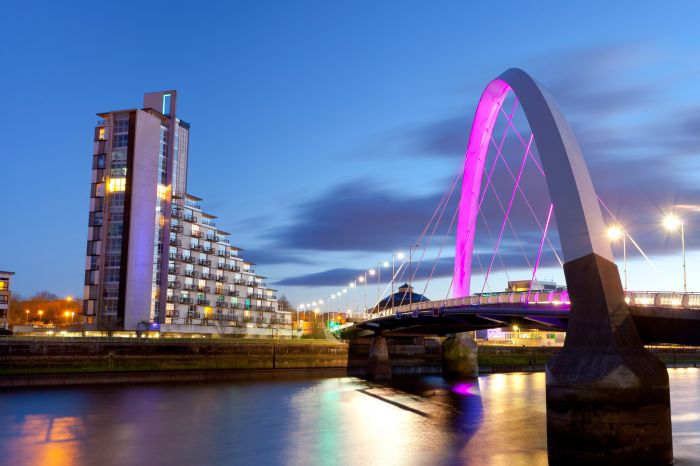
Planning a day trip from Glasgow involves more than just choosing a destination. Careful consideration of transportation, accommodation, and weather conditions is crucial for a smooth and enjoyable experience. This section provides essential factors for planning your perfect Glasgow day trip.Understanding the logistics and practicalities ensures you can fully immerse yourself in the destination’s charm without any last-minute stresses.
This guide will walk you through the necessary steps to make your day trip a success.
Transportation Options
Transportation is key to a successful day trip. Glasgow offers a variety of options, each with its own advantages.
- Trains are a popular choice for reaching destinations like Edinburgh, Loch Lomond, or the Scottish Highlands. They provide comfortable travel and often have scenic routes.
- Buses offer a more affordable alternative for many destinations, particularly for those located outside major train routes. Bus services are generally extensive and can provide access to remote areas.
- Cars offer flexibility, allowing you to explore at your own pace. However, parking can be a challenge in some areas, and traffic conditions should be considered.
Parking Options and Nearby Facilities, Glasgows best day trips
Finding parking, especially in popular tourist areas, can be a significant factor. Pre-planning is essential.
- Research parking options at your destination in advance. Some destinations have designated parking areas with varying rates and time limits. Look for car parks that are well-lit, secure, and have easy access.
- Consider the availability of amenities near the parking location. Are there restrooms, cafes, or shops conveniently located? These facilities can enhance your experience, particularly if you are traveling with children or have specific needs.
- Check for potential parking restrictions or limitations, especially during peak seasons. Regulations may vary depending on the location.
Booking Accommodations and Transportation
Booking in advance is highly recommended, especially during peak season.
- Accommodation availability varies greatly depending on the time of year and destination. Booking in advance ensures you secure your preferred lodging. Popular destinations often experience high demand during summer months or major events.
- Transportation options, particularly for peak-season trips, may have limited availability. Making reservations in advance for train tickets or buses can save you time and potential stress.
- Consider the flexibility of booking your accommodations or transportation in advance. This gives you the option to change plans if needed.
Weather Preparation
Weather conditions in Scotland can be unpredictable. Be prepared for a variety of scenarios.
- Check the weather forecast for your chosen destination and the days surrounding your trip. Scotland’s weather is often changeable, so be prepared for potential rain, wind, or even snow, especially at higher altitudes.
- Pack appropriate clothing layers for varying temperatures. A waterproof jacket and sturdy footwear are essential, regardless of the predicted temperature. Don’t underestimate the importance of packing layers; the temperature can fluctuate significantly throughout the day.
- Be aware of the potential impact of weather on your plans. Check for any road closures or advisories before embarking on your trip. If there’s a possibility of severe weather, consider postponing or adjusting your plans.
Food & Drink Experiences
Glasgow’s day trips offer a fantastic opportunity to sample diverse culinary experiences beyond the city’s bustling centre. From traditional pubs to charming cafes and upscale restaurants, the surrounding areas boast a vibrant food scene reflecting the local character and history. This section will explore the culinary highlights of various destinations, comparing prices, and offering recommendations for unforgettable dining adventures.
Restaurants and Cafes near Destinations
This section details restaurants and cafes located near popular Glasgow day trip destinations, providing a starting point for your culinary explorations. The availability and types of food and drink vary considerably across different areas, with some offering more traditional Scottish fare while others cater to international tastes. Proximity to attractions and the local environment will also influence restaurant choices.
- Loch Lomond & The Trossachs National Park: The area is well-served by pubs and cafes, often featuring hearty, home-style Scottish meals. Expect a mix of traditional fare like Cullen skink and smoked salmon, alongside more modern dishes. Prices tend to be moderate, reflecting the relaxed atmosphere and the generally lower cost of living in the area.
- Stirling: Stirling offers a wider range of dining options, including both budget-friendly pubs and upscale restaurants. Expect to find a balance between Scottish classics and international cuisine, particularly in the town centre.
- Edinburgh: Edinburgh, a major city, boasts an abundance of restaurants, ranging from quick bites to fine dining experiences. The variety of cuisines and price points is exceptional, with a focus on traditional Scottish dishes and international favourites.
Local Cuisine and Dining Options
Local cuisine often reflects the area’s history and resources. In rural areas, you’ll likely find a stronger emphasis on traditional Scottish dishes, utilizing fresh, locally sourced ingredients. City destinations offer a wider selection, including international cuisines.
Price and Quality Comparisons
The price and quality of food and drink vary significantly across different locations. Generally, rural destinations tend to offer more affordable options, with a focus on simple, high-quality dishes. City destinations like Edinburgh offer a wide range of choices, from budget-friendly pubs to expensive restaurants.
Best Local Foods and Drinks to Try
This section highlights the best local foods and drinks to experience during your day trip. Focus on regional specialities and dishes that reflect the unique character of the area.
- Loch Lomond & The Trossachs National Park: Try Cullen skink (a creamy fish soup) or venison stew. Local craft beers and whisky are excellent choices for beverages. These are often sourced from local producers, adding to the experience.
- Stirling: Explore local pubs for traditional Scottish dishes like haggis, neeps, and tatties (a hearty dish). Enjoy a pint of local ale. Consider a local brewery for a tour and tasting.
- Edinburgh: Edinburgh’s culinary scene offers a diverse range of options. Explore the city’s many restaurants for a variety of dishes, including Scottish seafood and internationally inspired dishes.
Restaurant Reviews and Recommendations
This section offers restaurant reviews and recommendations, based on personal experiences and feedback from other visitors. These will be based on factors such as atmosphere, food quality, and value for money.
- Loch Lomond & The Trossachs National Park: [Restaurant Name]: Known for its hearty Scottish fare and warm atmosphere. Prices are moderate, and the quality of the food is consistently high.
- Stirling: [Restaurant Name]: Offers a variety of Scottish and international dishes in a vibrant setting. The service is excellent, and the value for money is good.
- Edinburgh: [Restaurant Name]: Upscale dining experience with a focus on fresh, seasonal ingredients. Expect higher prices, but the quality and presentation of the food are outstanding.
Accommodation & Activities
Planning your day trip to Glasgow’s surrounding areas is made even more enjoyable with thoughtful considerations of accommodation and activities. Beyond the main attractions, exploring local amenities and experiences adds a layer of authenticity to your journey. This section details potential lodging options, highlights diverse activities, and provides practical comparisons for your decision-making process.
Accommodation Options
Choosing the right accommodation depends on your budget and preferences. Proximity to attractions and amenities is a crucial factor in ensuring a smooth and enjoyable day trip. Various options cater to different needs, ranging from budget-friendly guesthouses to charming boutique hotels. Consider these diverse possibilities to find the perfect fit for your trip.
- Budget-Friendly Stays: Hostels and guesthouses offer affordable lodging options, often with communal spaces and social events. They are excellent choices for budget-conscious travelers seeking to connect with others and experience the local atmosphere. For example, a hostel near a popular destination might offer dorm rooms and private rooms, providing a cost-effective alternative to more expensive hotels.
- Mid-Range Hotels: Mid-range hotels provide a balance between price and amenities. They often feature comfortable rooms, convenient locations, and various services like breakfast or free Wi-Fi. A hotel in a town with historical significance, for instance, might offer rooms with historical themes or city views, adding a unique touch to your stay.
- Luxury Accommodations: For a truly memorable experience, consider luxury hotels or boutique accommodations. These often boast exceptional amenities, personalized service, and stunning locations. A luxury hotel near a scenic area, for example, might offer spa treatments, fine dining options, and breathtaking views from private balconies.
Activity Options
The variety of activities available in the surrounding areas depends on the specific destination. From historical landmarks to outdoor adventures, there are options to suit every interest and pace. Consider a range of activities to ensure a diverse and enriching experience.
- Historical Sites: Many destinations feature historical sites, offering insights into the region’s past. Guided tours or independent exploration provide a deeper understanding of the area’s heritage. For example, a castle or stately home might host guided tours, providing information about its historical significance and architectural details.
- Outdoor Activities: Nature enthusiasts can engage in a variety of outdoor activities, such as hiking, cycling, or simply enjoying scenic walks. These activities offer opportunities to connect with the natural beauty of the region. A nearby park or woodland area, for example, might provide trails for various skill levels, offering stunning views and opportunities for fresh air.
- Cultural Experiences: Immerse yourself in the local culture through visits to museums, art galleries, or local festivals. These experiences allow you to appreciate the unique traditions and artistic expressions of the area. A local museum, for example, might exhibit regional crafts, showcasing the unique skills and artistry of the area’s inhabitants.
Accommodation Comparison
This table compares potential accommodations based on price, amenities, and location.
| Accommodation Type | Price Range (Estimated) | Amenities | Location |
|---|---|---|---|
| Budget Hostel | £20-£50 per night | Dorms, shared bathrooms, basic kitchen facilities | Typically near city centre or transport hubs |
| Mid-Range Hotel | £50-£150 per night | Private rooms, private bathrooms, breakfast, Wi-Fi | Often in town centres, near attractions |
| Luxury Boutique Hotel | £150+ per night | High-end amenities, fine dining, spa facilities, premium location | May be situated in a picturesque location or within a historic setting |
Alternative Activities & Local Amenities
Beyond the primary attractions, consider alternative activities and local amenities. Exploring local markets, visiting shops, or taking a shorter excursion can enhance your day trip experience. Discover unique aspects of the destination beyond the typical tourist sites.
- Local Markets: Many destinations have vibrant local markets showcasing regional produce, crafts, and local delicacies. These markets offer a taste of the area’s culture and provide opportunities to support local businesses. A farmers market, for instance, provides an opportunity to experience fresh, local produce and chat with the farmers themselves.
- Shopping Experiences: Local shops offer unique souvenirs, regional crafts, or local products. Support local businesses and discover items not easily found elsewhere. A small, independent bookstore, for example, might offer a unique selection of books or local authors, providing a personal touch to your shopping experience.
- Day Trips: Explore neighbouring towns or villages for additional activities and attractions. This allows for a more extensive exploration of the region. A nearby village with a scenic walk or historic buildings, for example, can be a great addition to your day trip, offering a change of pace and a chance to experience a smaller town’s charm.
Tips for Planning & Preparation
Embarking on a Glasgow day trip requires careful planning to ensure a smooth and enjoyable experience. From packing essentials to managing travel time and respecting the environment, these tips will help you make the most of your adventure. Consider your personal preferences and the specific day trip you’ve chosen when implementing these strategies.A well-prepared day trip is a happy day trip.
Glasgow’s got some amazing day trip options, from Loch Lomond to the charming towns around the area. If you’re looking for something fun to do while you’re planning your trip, check out some free coloring pages for museums and libraries, like free coloring pages museums libraries. Perfect for kids (and maybe even you!), these will keep little ones entertained on the journey and make your Glasgow adventure even better.
Knowing what to expect and being prepared for various scenarios will enhance your experience. This involves not just the practicalities but also the mindset of appreciating the journey and the destination.
Packing Essentials for a Day Trip
A well-packed bag is key to a successful day trip. This involves more than just stuffing clothes into a bag; it’s about strategically selecting items that cater to your needs. Consider the weather forecast, the activities planned, and your personal preferences.
- Appropriate clothing: Pack layers, as the weather in Glasgow can change quickly. A waterproof jacket, a warm sweater, and comfortable walking shoes are essential.
- Essential documents: Carry your identification, tickets, and any necessary travel documents.
- Personal items: Bring your wallet, phone, charger, and any personal medications.
- Snacks and drinks: Pack some healthy snacks and drinks to keep your energy levels up throughout the day. A reusable water bottle is also a great idea for staying hydrated.
- First-aid kit: A small first-aid kit with bandages, pain relievers, and any personal medications is a wise precaution.
Preparing for Different Weather Conditions
Glasgow’s weather is known for its unpredictability. Being prepared for rain, wind, or even sudden temperature drops is crucial for a comfortable day trip.
- Check the forecast: Always check the weather forecast before you leave. Be prepared for potential changes in conditions.
- Pack layers: Layers of clothing are key to adjusting to changing weather conditions. A waterproof jacket and a warm sweater are essential.
- Waterproof gear: Invest in a waterproof jacket, trousers, or a poncho to protect yourself from sudden downpours. Waterproof bags for electronic devices are also beneficial.
- Footwear: Wear sturdy, waterproof walking shoes to ensure comfort and support during your explorations.
- Accessories: A hat, gloves, and scarf can make a significant difference in maintaining warmth and comfort in cooler weather.
Creating a Smooth and Enjoyable Trip Checklist
A checklist is essential for ensuring a smooth and enjoyable day trip. This helps you avoid overlooking crucial aspects.
- Confirm transportation: Ensure your transport arrangements are finalized. Consider public transport options, carpooling, or taxis. Double-check bus routes or train schedules, especially for return travel.
- Plan your itinerary: Create a detailed itinerary with specific times for each activity. This helps you stay on track and maximize your time.
- Book tickets in advance: For attractions with limited capacity, pre-booking tickets online can save you time and potential disappointment.
- Charge devices: Ensure your phone, camera, and other electronic devices are fully charged before you leave.
- Pack a reusable bag: Carry a reusable shopping bag or backpack to help reduce your environmental impact.
Managing Travel Time Effectively
Efficient time management is crucial for maximizing your day trip experience. It helps you to avoid feeling rushed and allows for flexibility.
- Calculate travel time: Accurately estimate travel time to and from your destination, considering potential traffic or delays.
- Allow buffer time: Build in buffer time to your schedule to accommodate unforeseen delays or unexpected detours.
- Prioritize activities: Identify the most important activities and prioritize them on your itinerary. This allows you to stay focused on what truly matters to you.
- Set realistic goals: Set achievable goals for your day trip to avoid feeling overwhelmed and exhausted. It’s better to do a few things well than to try to cram too much into one day.
- Consider peak hours: Avoid travelling during peak hours if possible, as this can often lead to delays.
Staying Safe and Mindful of the Environment
Safety and environmental awareness are important aspects of any day trip. These tips ensure a safe and positive impact on the surroundings.
- Inform someone of your plans: Inform someone of your travel plans, including the destination, expected return time, and contact information.
- Be aware of your surroundings: Pay attention to your surroundings and be mindful of potential hazards.
- Respect local customs: Be respectful of local customs and traditions.
- Dispose of waste responsibly: Dispose of waste responsibly and practice sustainable habits.
- Minimize your environmental footprint: Choose eco-friendly options like public transport, and reduce single-use plastics to minimize your impact on the environment.
Illustrative Examples & Visuals
Planning a day trip from Glasgow is a fantastic way to explore the beauty and history surrounding the city. This section provides tangible examples of the diverse experiences waiting for you, illustrating how to envision your perfect day out. From immersing yourself in Scotland’s rich past to enjoying breathtaking views, we’ll explore the possibilities and how to plan for a memorable experience.
A Journey Through Time at Stirling Castle
Stirling Castle, a magnificent medieval fortress, offers a captivating glimpse into Scotland’s history. Imagine yourself wandering through the imposing castle walls, feeling the echoes of centuries past. The castle’s architecture is awe-inspiring, showcasing the craftsmanship of a bygone era. Explore the various rooms and courtyards, each with its own fascinating story. You’ll see firsthand the royal residences, battlements, and the intriguing details of daily life during medieval times.
Picture the grandeur of the castle on a crisp autumn day, the colours of the surrounding landscape complementing the historic stonework. This is a fantastic destination for history buffs and families alike.
Awe-Inspiring Views from the Trossachs National Park
The Trossachs National Park, a scenic wonderland just a short drive from Glasgow, boasts stunning natural beauty. Imagine yourself standing atop a high hill, gazing at the breathtaking panorama of Loch Lomond and the surrounding mountains. The crisp air, the lush greenery, and the shimmering water create an unforgettable vista. The vibrant colours of the Scottish countryside, particularly in spring and summer, are spectacular.
You can explore hiking trails that wind through forests and across meadows, taking in the breathtaking scenery. The park offers numerous picnic spots, allowing you to enjoy the tranquility and beauty of nature.
A Family-Friendly Day Trip to Loch Lomond
Loch Lomond, a stunning Scottish loch, provides a perfect setting for a family-friendly day trip. Imagine your children delighting in the many activities available, from boating and fishing to simply enjoying the scenic beauty. Pack a picnic lunch and find a tranquil spot by the loch, or rent a boat for a fun-filled experience. The numerous walking paths around the loch are perfect for a family stroll, providing opportunities for fresh air and exercise.
Many family-friendly attractions are located near Loch Lomond, such as playgrounds and visitor centres, making it a wonderful day out for all ages.
Transportation Options: A Visual Representation
| Destination | Transportation | Estimated Time | Notes |
|---|---|---|---|
| Stirling Castle | Train to Stirling, followed by a short bus ride or walk | Approximately 1 hour | Check train schedules and bus routes in advance. |
| Trossachs National Park | Car, or a combination of train and bus. | Approximately 1-2 hours | Car travel is recommended for flexibility. |
| Loch Lomond | Car, or a combination of train and bus. | Approximately 45 minutes | Consider using a local bus for ease of access. |
This table provides a simplified overview of the different transportation options. Detailed schedules and routes are readily available online.
Experiencing Local Culture at Loch Ness
Loch Ness, famous for the legendary monster, offers a unique glimpse into the local culture. The area is steeped in folklore and legend, creating a vibrant atmosphere. Visit local craft shops to see traditional Scottish crafts, and enjoy the warmth and hospitality of the local communities. Engage with local people at the numerous cafes and restaurants, and you’ll find that they are eager to share their stories and traditions.
The area has a long history of fishing and boat building, which is evident in the local culture. The friendly locals are a testament to the region’s unique charm.
Structure & Formatting
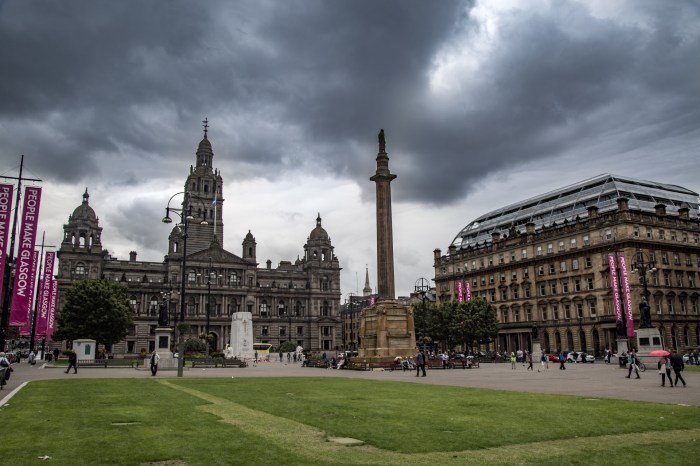
Glasgow offers a wealth of captivating day trips, ranging from historical explorations to scenic escapes. This section details the structure and formatting used to present this information effectively, making it easy to plan your perfect day out. We’ll use tables, lists, and quotes to highlight key destinations and provide practical tips.
Day Trip Destination Overview
This table presents a concise overview of various day trip destinations, highlighting key features and characteristics. It’s designed for quick reference and comparison.
| Destination | Type | Highlights | Distance from Glasgow |
|---|---|---|---|
| Loch Lomond & The Trossachs National Park | Scenic & Outdoor | Stunning landscapes, hiking trails, loch cruises | Approx. 1 hour |
| Stirling | Historical & Cultural | Stirling Castle, Wallace Monument, historic town | Approx. 30 minutes |
| Edinburgh | Historical & Cultural | Edinburgh Castle, Royal Mile, museums, vibrant city centre | Approx. 1 hour |
| Glasgow Cathedral & Necropolis | Historical & Cultural | Historic architecture, stunning city views, beautiful grounds | Within Glasgow city centre |
Tips for Planning a Successful Day Trip
Planning a successful day trip involves careful consideration of various factors. These tips offer guidance for a smooth and enjoyable experience.
- Check the weather forecast and pack accordingly. Sudden changes in weather can disrupt outdoor activities, so being prepared is key.
- Book accommodation and transportation in advance, especially during peak season. This ensures availability and avoids last-minute hassles.
- Research opening hours and ticket prices for attractions. This allows for efficient time management and avoids disappointment.
- Pack snacks and drinks to save money and reduce the need to make unplanned stops.
- Consider purchasing a travel pass if you plan to visit multiple attractions.
- Leave extra time for travel and unexpected delays. This allows for flexibility and reduces stress.
Popular Destinations
These destinations are consistently popular choices for day trips from Glasgow, offering diverse experiences.
- Loch Lomond & The Trossachs National Park: Known for its breathtaking scenery, hiking trails, and picturesque lochs, it provides a tranquil escape from the city.
- Stirling: A historic town with Stirling Castle, a magnificent fortress, and other historical sites, offering a fascinating glimpse into Scotland’s past.
- Edinburgh: The Scottish capital boasts iconic landmarks, museums, and vibrant nightlife, offering a rich cultural experience.
- Glasgow Cathedral & Necropolis: Explore the city’s history and architectural heritage through the impressive Glasgow Cathedral and the serene Necropolis.
Customer Testimonials
These quotes reflect the positive experiences of previous visitors.
“The Loch Lomond trip was absolutely stunning! The scenery was breathtaking, and the hike was challenging but rewarding. Highly recommended!”
Sarah M.
“Stirling Castle was incredible! The history and architecture were fascinating. A must-see for anyone visiting Scotland.”David B.
Concluding Remarks: Glasgows Best Day Trips
So, are you ready to embark on a day trip adventure from Glasgow? This guide provides a roadmap for exploring the best destinations. From the historical echoes of the past to the breathtaking beauty of Scotland’s landscapes, your perfect day trip awaits. Enjoy!
